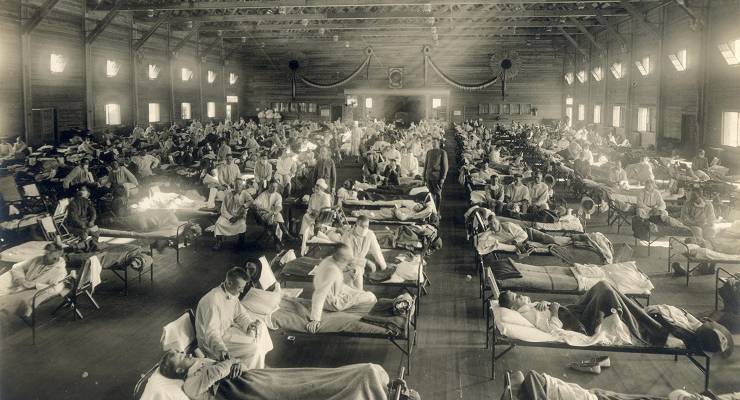
The virus arrived in a world bruised and broken by four years of war. Nobody knows where or how a devastating deadly strain of H1N1 A influenza virus took hold in the spring of 1918.
It could have started in Kansas, or in France, or China. In Spain, which stayed neutral during WWI, authorities didn’t censor the press to boost morale, leaving newspapers free to report on the virus. And that’s how it got its name: Spanish Flu.
By the year’s end, the virus was everywhere. Spread by a returning diaspora of soldiers, it killed in the United States, in the trenches of Europe, in India and Japan, South Africa and Brazil.
Death was messy and agonising. Oxygen starved bodies turned red, then purple, then black. Infected lungs filled with so much fluid that victims drowned in their beds, leaving behind sheets stained with blood and mucous. It killed quickly — within days, sometimes hours of infection. And, unlike most viruses, it hit the young and healthy with particular severity.
Australia was lucky. Thanks to an accident of geography, “pneumonic influenza,” as the flu was called here, took a while to reach our shores. Heeding warnings from the rest of the world, we banned planes from landing, and enforced a strict quarantine on all arriving boats.
Our defences held firm until January 1919, when the virus crept in. Once quarantine was breached, society shut down. Public life stopped. Churches closed their doors. Schools were converted into field hospitals, teachers turned into nurses. Doctors were rendered helpless.
All that could be done for patients was to nurse them, and hope for the best.
By the time the virus mysteriously petered out, 15,000 Australians had died. Across the world, the death toll was somewhere between 50 and 100 million, costing three times as many lives as the Great War.
And then, just like that, we forgot it. The deadliest virus ever known became another footnote to the war to end all wars.
Why did we forget?
Every town in Australia has a memorial to the ANZACs. Over a century later, our exploits in WWI, from the glorious failure of Gallipoli to the bloodshed on the Western Front remain etched into our national mythology.
But there are probably only a handful of monuments to the Spanish Flu in Australia. You’d be hard-pressed to even find it mentioned on a gravestone. Its centenary passed by with barely a whimper. And until COVID-19 changed our world, it was the “forgotten pandemic,” its memory kept alive by a smattering of dedicated historians.
One of those historians is the University of Sydney’s Peter Hobbins, who says while memory of the pandemic has dwindled, the Australians who lived through it never forgot.
“Effectively, the Spanish Flu was part of everyone Australian’s family history. Everyone knew someone who was infected,” Hobbins told Crikey.
Up to a third of the Australian population got the Spanish Flu. People remembered the masks, the compassionate community members who gave food and shelter, the sacrifice of ordinary people who nursed the ill, the black-ribboned funeral horses. They remembered the deaths of friends and family, priests, mayors, doctors and bakers.
Those memories stayed with Australian families for decades. But they also literally embedded itself in our immunological memory, with studies from the 1990s finding that people who’d been infected decades earlier still had the antibodies to show for it.
The virus changed Australia profoundly. Before 1919, the idea of the Commonwealth playing a role in healthcare was entirely alien. But it was the experience of mobilising a nation’s medical resources, of imposing quarantine, that led to the creation of a federal health department two years later. Throughout the 1920s, Australia looked inward, sceptical of a world that had caused us so much suffering.
But the horrors of WWI loomed so large over Australia, and the world, that all the death and disruption the flu brought to the home front has been subsumed into the chaotic historical moment. The war overwhelmed in our memory, while the pandemic became its forgotten, tragic epilogue.
The way the pandemic faded from view tells us something important about the kind of stories we as a society choose to remember. For centuries, we’ve equated war and conquest with glory. Such stories form the backbone of so much of our art, literature, and historical narrative. Illness, on the other hand, is seen as altogether weaker, quieter, less exciting stuff.
In her essay On Being Ill, Virginia Woolf, who lived through the Spanish Flu, laments a collective cultural failure to articulate sickness.
“Those great wars which it [the body] wages with itself … in the solitude of the bedroom against the assault of fever or the oncome of melancholia are neglected,” she writes.
And so it was with the Spanish Flu.
“It wasn’t seen as glorious, it wasn’t seen as a sacrifice, it was seen as something beyond the control of Australians,” Hobbins said.
“It wasn’t like the Great War, where the men who joined up to fight were seen as having made a courageous sacrifice. People who faced Spanish Flu were equally courageous, but it wasn’t seen as valorous in the same way.”
Carolyn Fraser, lead curator at the State Library of Victoria, says the drama of the Spanish Flu took place in the home, a space traditionally marginalised and undervalued by history.
“We assume history is made on the battlefields, or in the houses of parliament.”
Remembering the pandemic
This year, as the coronavirus broke out in cities across the world, killing thousands and grinding global capital to a halt, we finally began to remember the Spanish Flu.
Looking back at events over a century ago, the parallels with our current experience are striking — the way the virus spread silently before we even knew it, the streets and workplaces which emptied out overnight, the bodies dumped in makeshift mass graves, Australia’s comparative good fortune.
It seems unthinkable to imagine COVID-19 being forgotten like the Spanish Flu. In 2020, there’s never been a greater record of the kinds of intimate, personal stories, and of the parts of our lives where the Spanish Flu played out. The minutiae of our collective experiences are all documented on social media — a real-time archive ready to be ripped off a dusty, forgotten Silicon Valley server decades from now.
But is that really good history? Even for those of us navigating it in the present, the internet is a wildly disorienting, dizzying cacophony of memes and misinformation. What would a historian, decades from now, make of references to 5G, Bill Gates, and the president of the United States telling people to inject themselves with disinfectant? Can social media platforms, where reality is under siege, really form part of a robust history of our present moment?
A better form of collection is happening, not in our Twitter feeds, but through old fashioned public institutions like libraries, museums and galleries. The State Library of Victoria’s Memory Bank project, which calls on people to donate the kind of everyday artefacts that tell stories of their life under the pandemic, is one such attempt to build an archive. Similar collection drives are taking place in libraries across the country.
“Some people think libraries and museums are only interested in collecting things of aesthetic or economic value,” Fraser, who’s running the Victorian project, told Crikey.
“But often it’s the ephemera that’s most valuable — people’s reflections, receipts for the things they buy, the kinds of letters and diaries they might keep and share.”
Collecting objects that might otherwise seem mundane is a kind of art. When our phones become obsolete, when we ditch social media platforms, it’s archivists who will still be out there trying to migrate and preserve our digital memories.
All those pieces matter if we want this moment to be remembered. Maybe, unlike the Spanish Flu, the coronavirus won’t fade from the Big Historical Picture. Perhaps as a culture, we’ll choose to honour and valourise health workers like we did soldiers in 1919.
But history shouldn’t need heroes. Our personal memories, the anxious monotony of isolation, the experiences of young, healthy people brought to their knees by COVID-19, are all equally valid. But the process of making those memories stand the test of time lies with us.








Covid-19 will be forgotten in much less than 100 years. It will be virtually gone from people’s memories in a decade. People’s lives have been disrupted – but not nearly as significantly as they think. Things will revert to normal (not a new normal, just the same old normal unfortunately) before we know it. It’s already starting to happen in the NT, where last Friday night in Darwin it seemed to be pretty much business as usual – slightly quieter than the average dry season Friday evening, but not much. It will be the same everywhere else soon.
Beautiful essay, Kishor. Memory is active, creative, political, and endlessly being made and remade, like history itself.
Pretty sure they didn’t stop the planes landing.
COVID 19 will be forgotten before too long, because it will be overtaken by more momentous events in the near future.